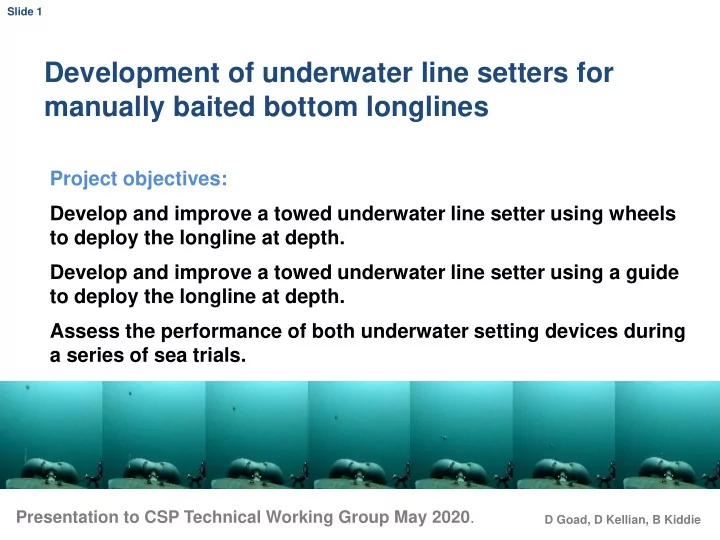

Slide 1 Development of underwater line setters for manually baited bottom longlines Project objectives: Develop and improve a towed underwater line setter using wheels to deploy the longline at depth. Develop and improve a towed underwater line setter using a guide to deploy the longline at depth. Assess the performance of both underwater setting devices during a series of sea trials. Presentation to CSP Technical Working Group May 2020 . D Goad, D Kellian, B Kiddie
2. Manually baited snapper longline gear Snoods (hooks, clip, and trace) stored on cards Snoods manually clipped onto a stoppered backbone Floats and weights clipped on alone and together
3. Manually baited snapper longline gear 1 or 2 sets per day, usually 1 before dawn, occasionally in day 500 - 7000 hooks per day
4. Concept winch mainline not to scale stoppers hook card boat sea surface snood and hook tow cable wheel tow point paravane hinge lead ball plan view
5. Challenges Deploying the mainline at depth Tangles Bait retention Depth (vs speed) Consistency Weights, floats, surface floats Turns
6. Research approach No literature / how to guides Process of iterative improvement 1. Identify problems that need fixing 2. Make modifications 3. Trial new version, record data (measurements and video) 4. Assess performance (review video, data) Repeat
7. Setter with a wheel Objective: Use a combination of wheel and clip design to turn snoods and hooks beside the wheel.
8. Different wheel and clip designs
9. Deploying floats and weights
10. Results / Conclusions Concept does work, baits don’t touch wheel. More development needed: • Consistency • More clip / wheel refinement • Eliminating catch points • Reliably setting floats and weights • Dealing with snoods tangled around mainline
11. Setter with a guide Objective Improve and quantify performance Between trips - Refine guide shape and orientation Between deployments - Refine settings: weight distribution, paravane, rudder Within deployments - Adjust tow cable length, line tension Measure response: Depth, bait retention, catch
12. Results Successfully deploying weights, float weight combinations, and surface floats. Successfully deploying squid and sanma baits at depth with minimal damage. Pilchard bait is fragile – loss rates are unacceptable, even before snood reaches setter. Baits are lost and damaged just by pulling them rapidly through the water. Mainline tension requires further investigation.
13. Mainline tension Better setter performance (depth, bait loss) at high mainline tension BUT poor snapper catch rates at high mainline tension Need to strike the balance Requires accurate measurement and control of line tension
14. Next steps Develop line tension meter Find the optimum guide setter configuration to minimise bait loss whilst setting at minimal mainline tension. tow cable length adjustable paravane joint line tension setting speed hinge limiter guide shape rudder lead ball Measure catch rates vs control treatment of normal set
15. Acknowledgements Skippers, owners, crew, engineers, CSP team
Recommend
More recommend